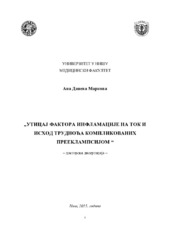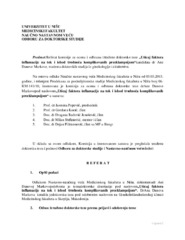Приказ основних података о дисертацији
Uticaj faktora inflamacije na tok i ishod trudnoća komplikovanih preeklampsijom
| dc.contributor.advisor | Stefanović, Milan | |
| dc.contributor.other | Popović, Jasmina | |
| dc.contributor.other | Janošević-Radović, Dragana Ž. | |
| dc.contributor.other | Kocić, Gordana | |
| dc.contributor.other | Filimonović, Dejan | |
| dc.creator | Daneva Markova, Ana | |
| dc.date.accessioned | 2016-03-20T17:05:29Z | |
| dc.date.available | 2016-03-20T17:05:29Z | |
| dc.date.available | 2020-07-03T16:06:52Z | |
| dc.date.issued | 2015-07-03 | |
| dc.identifier.uri | http://eteze.ni.ac.rs/application/showtheses?thesesId=2532 | |
| dc.identifier.uri | https://nardus.mpn.gov.rs/handle/123456789/4990 | |
| dc.identifier.uri | https://fedorani.ni.ac.rs/fedora/get/o:1029/bdef:Content/download | |
| dc.identifier.uri | http://vbs.rs/scripts/cobiss?command=DISPLAY&base=70052&RID=1025356525 | |
| dc.description.abstract | Preeclampsia is a common disorder of pregnancy characterized by disturbed placentation and hemodynamic response to pregnancy. It remains to be a leading cause of maternal morbidity and mortality and is associated with a significant increase in perinatal mortality, a clear etiology and pathophysiology is still unknown. It occurs in 3-14% of all pregnancies in the world and to moderate pre-eclampsia by 75% and 25% severe preeclampsia. Early prediction and prevention of pre-eclampsia is a dream of many obstetrician during generations. We used the number of tests (biophysical, biochemical ...) during the years of testing (more than 60 tests), but none of them gave the expected results of reliability as the sole test. More markers of inflammation and inflammatory responses has been studied in pre-eclampsia, in order to define their role in the pathogenesis and disease prediction. Many studies have addressed the role of inflammation in the pathogenesis of preeclampsia. However, little is known about the relationship between the severity of inflammation and severity of preeclampsia due to insufficient testing on this topic. Aim Since prevention is not possible to estimate severity of disease intensive supervision during the further course of pregnancy should be the target. 1. To determine the effect of the levels of cytokines on the clinical parameters of pregnant women with preeclampsia. 2. Define the demographic and socio-economic characteristics of pregnant women with the risk of pre-eclampsia in Macedonia,. 3. Assessment the impact factors of inflammation in certain biophysical and biochemical markers for prediction of severe preeclampsia in relation to women in the general obstetric population. 4. Evaluate the diagnostic and prognostic test options concentration levels of inflammation factors in maternal serum as a test to assess the severity of preeclampsia in the third trimester of pregnancy. 5. Determinate the dependence of pregnancy, mode of completion and perinatal outcomes in relation to inflammatory response Materials and methods The study was conducted as prospective study at the University Clinic of Gynecology and Obstetrics, University "Ss. Cyril and Methodius" in Skopje, Macedonia. The study included 50 pregnant women with singleton pregnancies between 28 and 40 gestational weeks hospitalized with symptoms of pre-eclampsia, determined by standard clinical laboratory analysis. The control group consisted of 50 normotensive pregnant women of the same gestational age (+ / - 1 Week), parity (primapara, parity 1 to 4 and parity> 4) and maternal age (<20 years, 20 to 35 and> 35 years). After obtaining consent for participation in the examination of every pregnant woman, we took a detailed history, perform cardiotocography, ultrasound biometry and Doppler of fetomatemal unit, we took a blood sample to determine the appropriate serum concentrations of appropriate markers. Clinical laboratory testing to assess the severity of pre-eclampsia (moderate or severe). Inflammatory cytokines were analyzed from peripheral blood 1-1,5ml by enzymatic amplification chemiluminescence on the device Immulite 1000, Siemens Healthcare Diagnostics, USA. The duration of pregnancy, method of delivery, birth weight and length of the child at birth, Apgar score, are also analyzed. The data were digitized and all statistical tests were performed using SPSS version 13.0. We used descriptive statistical analysis that we would display the following parameters: mean, standard deviation, coefficient of variation, variation interval. Categorical variables were tested using Chi square and Fisher exact tests and quantitative variables were analyzed with independent sample test and Mann-Whiteney's U test to determine the correlation between the variables we used Spearman Rank Correlation Orded test and Pearson's linear correlation coefficient. We used binary logistic regression to determine the predictive role of the parameters analyzed. Results The average age of pregnant women included in the study was 32.06 ± 4.8 in the range of 20 to 40 years. Our data indicate a significant relationship between nulliparity, age, pregnant women, their nutritional status assessed by BMI and their religious convictions. History pregnant women about previous obstetric complications associated with hypertension, diabetes and smoking are important predictors of preeclampsia in our study. Multiple analysis of this study as independent significant factors for severe pre-eclampsia, confirms the ages of pregnant women: a systolic blood pressure of 160 mmHg and higher diastolic blood pressure of 100 mmHg and higher, the existing proteinuria, serum LDH values of 450 and above, and reduced serum concentrations of IL-4 and IL-tenth. Preeclampsia has a significant impact on the mode of delivery and newborn weight. The results of our study show that the birth by caesarean section is indicated in 10% of normotensive pregnant women and 46% in pregnant women with preeclampsia (52% severe, moderate 40%). Pregnancy ended with preterm delivery at 20% of normotensive pregnant women and insignificantly higher percentage of 36% in the group with preeclampsia. Tested differences between the analyzed groups in relation to the fetus (IUGR and SGA) show that pregnant women with preeclampsia often give birth with SGA, regardless of the severity of the disease, compared to normotensive pregnant women. Conclusion Comparison of changes in the profile of cytokines with increasing severity of preeclampsia may allow us to determine the level of compensation of pathological conditions that reflects the level of implementation and functional reserves of various mechanisms to maintain homeostasis. This happens in the background of increased concentrations of other proinflammatory cytokines and decreased levels of anti-inflammatory cytokines IL-4 and IL-10. 1. Multiple analysis of this study as independent significant factors for severe pre-eclampsia confirms: age ≥ 35 years, nulliparity and ethnicity, and as insignificant factors confirms smoking, Diabetes gestationes and preeclampsia in prior preegnancy. 2. In pregnant women with mild preeclampsia there is increase of IL 1β, IL 2, IL 4, IL 8, IL 10, TNF and IL 6 (statistically significant) compared with normotensive pregnant woman. 3. In pregnant women with severe preeclampsia significantly reduces the levels of IL 4 and IL 10, and increasing the levels of IL 2, IL 6, IL 8, IL 1β, and does not change significantly the level of TNF compared with normotensive pregnancies. 4. Preeclampsia has a significant impact on the way of delivery and newborns weight. In pregnant women with preeclampsia and low levels of factors of inflammation significantly higher percentage of deliveries were by Caesarean section, a significantly smaller percentage of vaginaldelivery.Preterm births insignificantly is in higher percentage in pregnant women with preeclampsia compared to control group. 5. The best statistical model for predicting the severity of preeclampsia is the correlation of the levels of serum interleukin (IL-4 and IL-10) with indicators of pre-eclampsia: LDH, creatinine, uric acid, and platelet count. However, the study is only the beginning of this type of research in our population. Further research is needed in terms of evaluating the costs and benefits of using such a test in order to prevent subsequent unnecessary interventions in groups with low risk, and realizing the benefits of such interventions in high-risk groups, the patient is given. | en |
| dc.format | application/pdf | |
| dc.language | sr | |
| dc.publisher | Универзитет у Нишу, Медицински факултет | sr |
| dc.rights | openAccess | en |
| dc.rights.uri | https://creativecommons.org/licenses/by-nc-nd/4.0/ | |
| dc.source | Универзитет у Нишу | sr |
| dc.subject | citokini | sr |
| dc.subject | cytokines | en |
| dc.subject | TNF-α | sr |
| dc.subject | umerena preeklampsija | sr |
| dc.subject | teška preeklamsija | sr |
| dc.subject | faktori predikcije | sr |
| dc.subject | TNF-α | en |
| dc.subject | moderate pre-eclampsia | en |
| dc.subject | sever pre-eclampsia | en |
| dc.subject | prediction factors | en |
| dc.title | Uticaj faktora inflamacije na tok i ishod trudnoća komplikovanih preeklampsijom | sr |
| dc.type | doctoralThesis | en |
| dc.rights.license | BY-NC-ND | |
| dcterms.abstract | Стефановић, Милан; Поповић, Јасмина; Коцић, Гордана; Јаношевић-Радовић, Драгана Ж.; Филимоновић, Дејан; Данева Маркова, Aна; Утицај фактора инфламације на ток и исход трудноћа компликованих прееклампсијом; Утицај фактора инфламације на ток и исход трудноћа компликованих прееклампсијом; | |
| dc.identifier.fulltext | https://nardus.mpn.gov.rs/bitstream/id/53054/Disertacija622.pdf | |
| dc.identifier.fulltext | http://nardus.mpn.gov.rs/bitstream/id/53054/Disertacija622.pdf | |
| dc.identifier.fulltext | http://nardus.mpn.gov.rs/bitstream/id/53055/Daneva_Markova_Ana.pdf | |
| dc.identifier.fulltext | https://nardus.mpn.gov.rs/bitstream/id/53055/Daneva_Markova_Ana.pdf | |
| dc.identifier.rcub | https://hdl.handle.net/21.15107/rcub_nardus_4990 |



